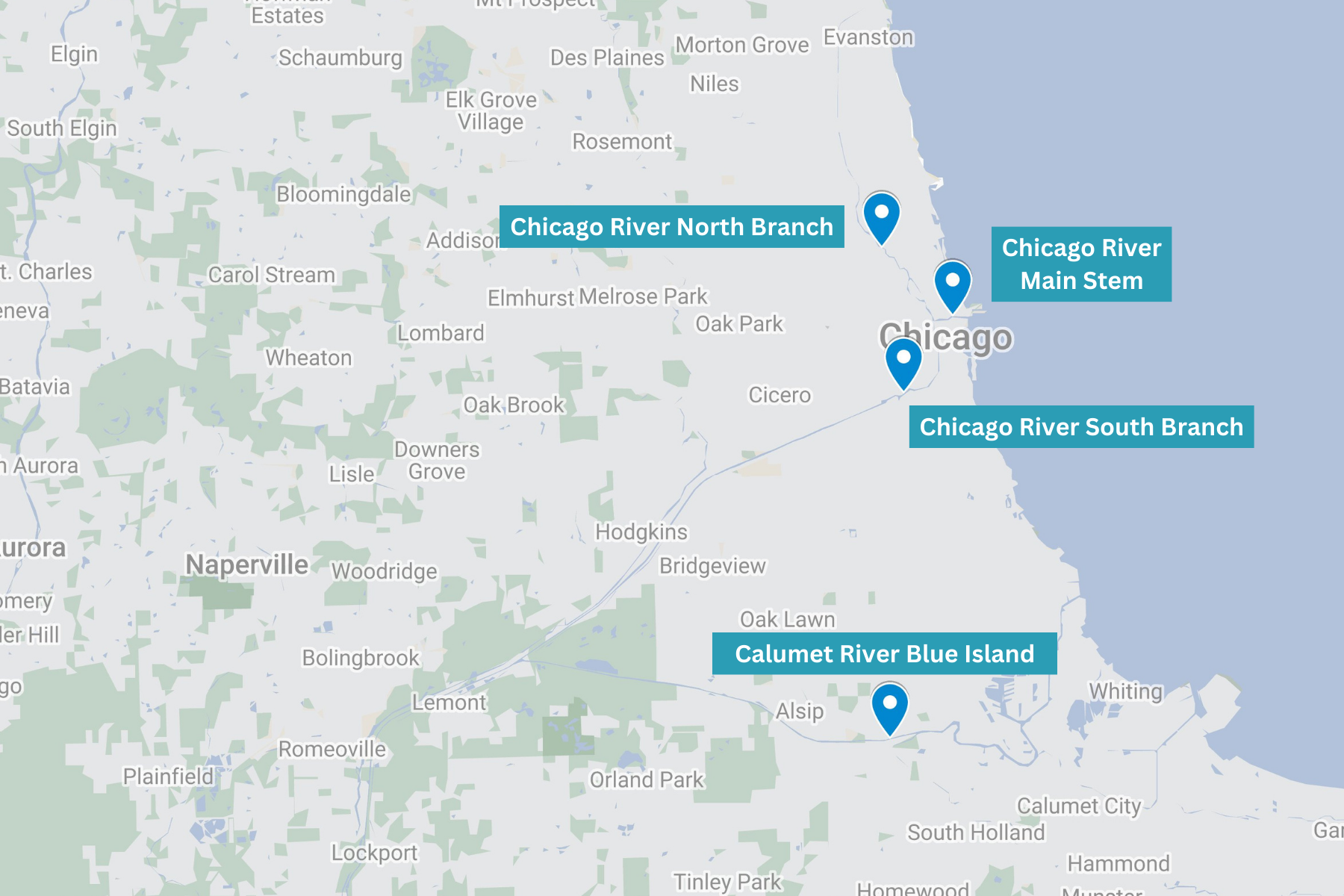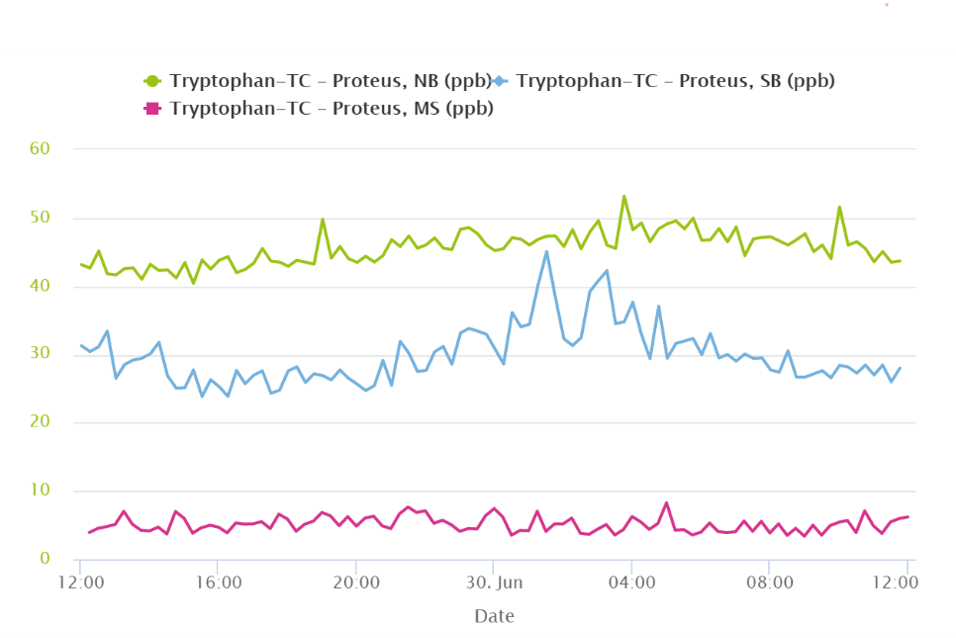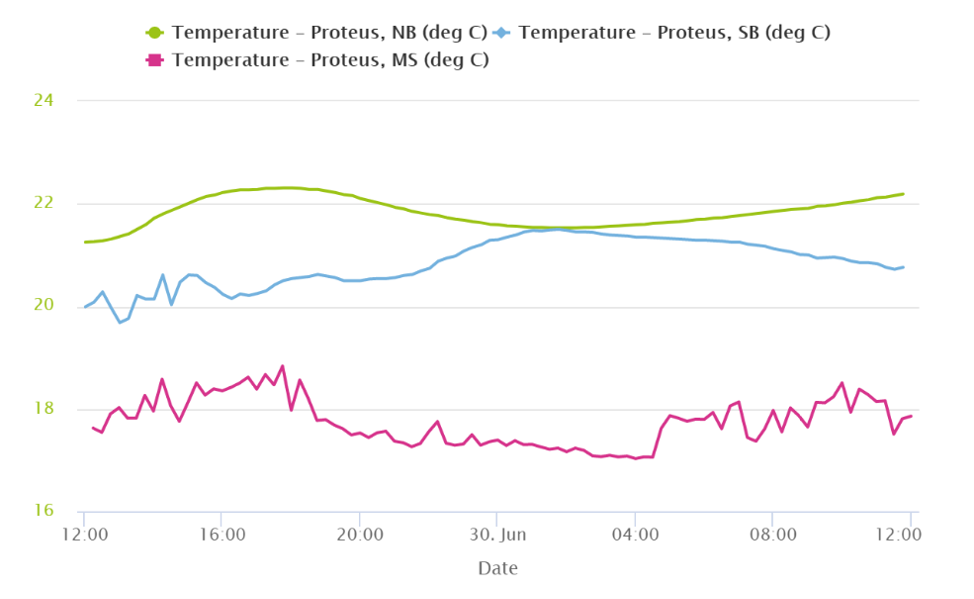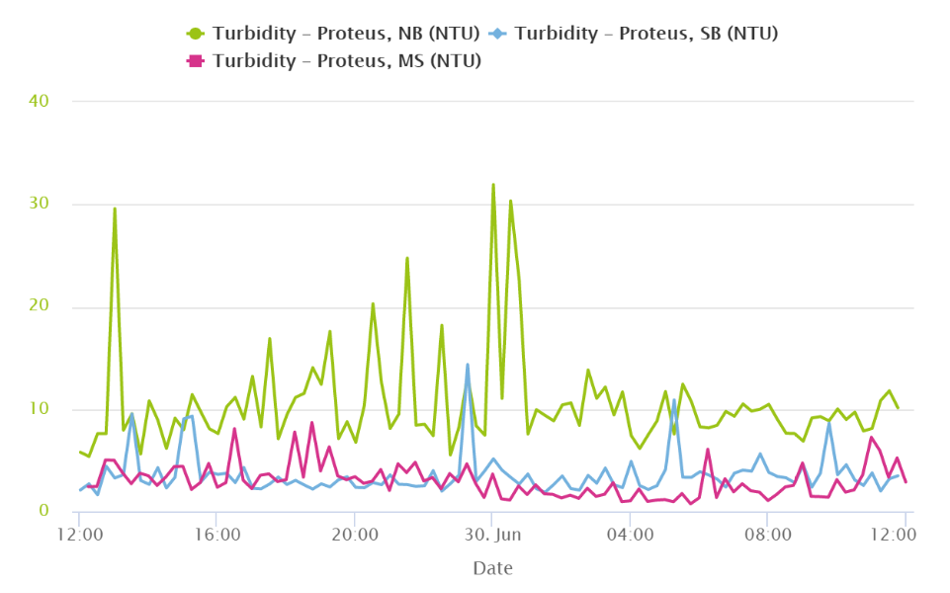
Frequently Asked
Questions
WHAT IS H2NOW CHICAGO?
H2NOW Chicago is like a weather app for the Chicago Area Waterway System (CAWS). It estimates real-time microbial water quality conditions along all three branches of the Chicago River and at Blue Island along the Calumet River (see map). The types of sensors we use, allowing for the communication of real-time data, are relatively new technology (within the last five years). To date, monitoring of river bacterial water quality has been accomplished by sending river samples to a lab and waiting at least a day for the results. With H2NOW, the river’s variable water quality can be tracked every 15 minutes, a big improvement for everyone who wants to interact with and enjoy the River.
Current uses the H2NOW Chicago platform to pilot new technologies, to answer more questions, including: What percentage of the feces in a river is from humans vs. from livestock or birds, for example? Has a new contaminant arrived in the river or greatly increased? We hope to export successful technology to other cities and extract more information about rivers.
WHAT DOES H2NOW CHICAGO MONITOR?
H2NOW monitors river temperature, turbidity (how cloudy or clear the water is), specific conductivity (salinity), colored dissolved organic matter (CDOM), and tryptophan-like fluorescence (TLF) with Proteus multiprobes. The team also collects river samples on a monthly basis from each of the four monitoring sites and sends the samples to an analytical lab for fecal coliform (FC) analysis. The sensor data, collected and transmitted every 15 minutes, feeds a mathematical model that estimates FC numbers at each site and produces a water quality assessment. This assessment is then displayed on the front-page gauges, which suggest to the public the level of caution they should exercise when recreating on the river. The FC tests conducted monthly during the recreational season help verify and adjust the model, if necessary, in order to deliver to the public the most accurate assessment possible.
WHY IS H2NOW CHICAGO USING TLF AND CDOM SENSORS?
TLF is an optical sensor that emits and detects electromagnetic frequencies associated with fluorescence of the amino-acid tryptophan. Because of that, researchers have investigated its ability to estimate concentrations of microbes in water. CDOM is similar to TLF, but it deploys different electromagnetic frequencies, more strongly associated with natural organic matter content of water.
Our team uses TLF, together with CDOM, temperature, and turbidity to estimate fecal coliform levels in the rivers. The water quality model has improved every year since launching H2NOW in 2021 as we learn more about how the parameters that we monitor interact with one another. We also monitor specific conductivity, but that parameter shows little influence on the water quality model.
*Other references:
1. Jade S.T. Ward, Daniel J. Lapworth, Daniel S. Read, Steve Pedley, Sembeyawo T. Banda, Maurice Monjerezi, Gloria Gwengweya, Alan M. MacDonald, Tryptophan-like fluorescence as a high-level screening tool for detecting microbial contamination in drinking water, Science of The Total Environment, Volume 750, 141284.
2. Bedell, E., Sharpe, T., Purvis, T., Brown, J., Thomas, E. (2020) Demonstration of Tryptophan-Like Fluorescence Sensor Concepts for Fecal Exposure Detection in Drinking Water in Remote and Resource Constrained Settings. Sustainability. V. 12, 3768; doi:10.3390/su12093768
WHAT ARE FECAL COLIFORMS AND WHY ARE THEY MONITORED?
Fecal coliforms are bacteria that originate from warm-blooded animal feces, including humans, and can spread in waterways from large events, like sewage overflows or less conspicuous point sources, such as surface runoff that picks up animal feces left on the ground. They are members of two bacteria groups: coliforms and fecal streptococci. Many are not harmful to humans, but they are used as indicator organisms because they can alert us to the potential presence of other disease-causing bacteria, viruses and protozoans living in the water.
Engaging with water that has high levels of fecal coliform bacteria increases your chance of developing a mild illness, such as: gastrointestinal symptoms of vomiting and diarrhea; respiratory problems like colds, coughs and sore throat; eye redness and irritation; ear pain or ear infection; and skin rash. These occur when pathogens enter the body through the mouth, nose, ears or cuts on the skin. The U.S. EPA uses fecal coliform bacteria as indicator organisms to identify potential human health risks in a body of water.
H2NOW is measuring fecal coliforms because portions of the Chicago River and the Calumet River are designated for Primary Contact Use by the Illinois Environmental Protection Agency (IEPA). That means that the rivers are designated for recreational use, and the water quality regulation for FCs is that based on a minimum of five samples taken within a 30-day period, FCs should not exceed a geometric mean of 200 per 100 ml of water, nor shall more than 10% of the samples during any 30-day period exceed 400 per 100 ml of water, in protected waterways. (35 Ill. Adm. Code Section 302.209). This water quality standard is the basis for the H2NOW microbial water quality assessment.
WHY ARE THERE FECAL COLIFORMS IN THE WATER?
Fecal coliform bacteria may occur in ambient water (open waters, such as rivers and lakes) as a result of several factors: sewage overflow, stormwater/nonpoint sources of human and animal waste accumulated through runoff, and sediments, which may be stirred up by boats (Microbial Source Tracking). This means that the levels of fecal coliform in the water can be elevated during wet weather without a Combined Sewer Overflow event.
WHERE IS H2NOW MEASURING WATER QUALITY?
Four real-time water quality monitoring probes have been placed in the North Branch, Main Stem and South Branch of the Chicago River and at Blue Island in the Calumet River. The North Branch location is upstream of Goose Island, the Main Stem location is just east of Michigan Ave, and the South Branch location is in the vicinity of the Eleanor Boat House. The Calumet River Blue Island location is in the vicinity of the Division Street bridge.

WHAT INSPIRED H2NOW?
Chicago’s rivers are one of our region’s greatest assets, but like many urban rivers, they need to be restored from years of heavy industrial use. In 2016, a major community planning called Our Great Rivers was launched with the goal of making the Chicago, Calumet and Des Plaines Rivers into desirable, accessible destinations for all residents to use for recreation and economic development. Gathering and sharing real-time information about river water quality was a goal set forth in the Great Rivers vision.
WHAT ARE THE GOALS OF THE H2NOW PILOT PROJECT?
Our goals are:
- Understand the factors that affect microbial water quality in the Chicago Area Waterway System (CAWS).
- Enable well-informed decisions about when and how interaction with the Chicago rivers is safe, and determine when it is appropriate to encourage more interaction with the waterway and its many opportunities for recreation, work and relaxation.
- Enhance public engagement with the rivers, driving sustainable development - from recreational providers to real estate developers.
- Improve the public’s understanding of the effects of combined sewer overflows, storm water runoff and point source pollution.
- Provide government entities, industries and utilities with data intelligence that can direct short and long-term environmental planning, as well as sustainable infrastructure investment in a way that is effective and cost-efficient.
- Further Chicago's reputation as a water innovation leader. No other U.S. city is currently monitoring and publicly communicating real-time microbial water quality data.
- Operate in alignment with the United Nation’s vision to support and strengthen the participation of local communities in improving water and sanitation management.
HOW OFTEN IS THE WATER TESTED?
The Proteus probes take measurements every 15 minutes. The sensor data are transmitted to a cloud-based data platform and a fecal coliform estimate is immediately generated. The FC estimate is then transmitted to the H2NOW website. The H2NOW Chicago sampling team collects river samples near where the probes are installed and sends the samples to analytical lab fecal coliform analysis. The lab results are subsequently compared to the model-produced results to verify model performance and, if necessary, adjust its parameters.
WHAT ARE CFUS?
CFU is an abbreviation for “Colony Forming Unit”. It is a term often used to measure bacteria, like fecal coliforms, in water. Simply stated, CFUs are the number of bacterial colonies or clusters visible in a sample after testing (see the image below). CFUs are typically reported for a 100 mL volume of a sample.
 Source: USGS, 2017.
Source: USGS, 2017.
HOW EXACTLY IS RECREATION (E.G., SWIMMING, KAYAKING, ETC.) WATER QUALITY DETERMINED?
The Illinois Environmental Protection Agency (IEPA) states that based on a minimum of five samples taken within a 30-day period, fecal coliforms should not exceed a geometric mean of 200 per 100 ml of water, nor shall more than 10% of the samples during any 30-day period exceed 400 per 100 ml of water, in protected waterways. (35 Ill. Adm. Code Section 302.209)
WHAT CAUSES MICROBIAL POLLUTION IN THE RIVERS?
Surface run-off; rain washes it from the ground
- 1,834 square miles of rainwater across three states drains into the Chicago River, from Calumet, Indiana, to Kenosha, Wisconsin
Sewage overflows
- Reminder: Engineers reversed the flow of the Chicago River, so our sewage traveled away from Lake Michigan, the source of our drinking water, in 1900.
- When we get heavy rains, our sewer system gets overwhelmed and the excess sewage overflows into the river with the rainwater.
- In the absolute worst cases -- such as torrential rains in 2013 -- the flow of the Chicago River is reversed, opening the gates between the River and Lake Michigan, to relieve pressure on the sewer system.
This is why our rivers are far from perfect.
WHY ARE SENSOR READINGS DIFFERENT AT EACH MONITORING SITE?
Tryptophan-like fluorescence (TLF) readings are different at each monitoring site, as can be clearly observed on the plot below.

Values of other parameters, such as specific conductivity, colored dissolved organic matter (CDOM), temperature, and turbidity, also differ from site to site.



There are several factors that can be causing these differences. Some of them include:
- Different channel geometry (different average depth and width). The North Branch is the shallowest and narrowest of the three and, therefore, experiences higher flows, which may be the reason why turbidity is generally higher on the North Branch. . Water temperature is also slightly higher on the North Branch, likely because the water is quicker to warm up due to this stretch being shallower.
- Different sources of water. The North Branch water is highly influenced by treated wastewater, which is discharged by the O’Brien Water Reclamation Plant into the North Shore Channel. The plant treats wastewater to the required standard and then disinfects it, but some of the remaining organic and inorganic constituents may be responsible for the higher TLF, CDOM, and specific conductivity measurements. The Main Stem water comes from Lake Michigan, which is the source of drinking water to the City of Chicago and many surrounding communities. Lake Michigan water is colder than that of the river and it is also visibly clearer. This is why the Main Stem sensors show lower temperature and turbidity. TLF, CDOM, and specific conductivity readings are also much lower on the Main Stem than on the North Branch. The South Branch combines the flow from the North and South Branches and, not surprisingly, its sensor readings typically fall somewhere in between the two other Chicago River locations.
- Different uses. The North Branch is typically used by kayakers and small boats, while the Main Stem and South Branch are designed for commercial navigation. In the spring, summer, and early fall, the Main Stem is heavily used by large tourist boats and smaller recreational boats, which raises turbidity.
- Different surroundings. The effect of varying surroundings on water quality is hard to underestimate. In urban areas with an abundance of impervious surfaces and lack of adequate drainage, stormwater runoff may pollute the river. More natural areas will attenuate (soak up) the effect of stormwater runoff. Industrial and commercial areas may introduce industry-specific pollutants, such as heavy metals and PFAS. One thing that all three branches of the Chicago River have in common, though, is the abundance of sewer outfalls (close to 200 total). When sewers fill to capacity, they will spill into the river to prevent urban flooding.
WHAT IS A CSO AND HOW DO I KNOW ONE HAS OCCURRED?
A Combined Sewer Overflow (CSO) occurs when heavy rain or floods cause heavy flow of stormwater into Chicago’s wastewater system, overwhelming its holding capacity. The early Chicago sewer system, like most sewer systems of its time, was built primarily to carry human waste away from the city and was not designed for either stormwater influxes or for servicing this many residents. Today, influxes of stormwater can cause sewage to spill into waterways. Although the MWRD’s Tunnel and Reservoir Plan (TARP) has significantly reduced the number of CSOs, they still occur during heavy rain events.
CSOs result in an uptick in fecal coliform in the Chicago River due to contamination from sewage, which can be seen as a high spike in TLF readings on the H2NOW platform. Lab analysis of river water samples taken from the probe sites after these events confirm that CSOs correlate to an increase in fecal coliform levels as well as TLF. MWRD keeps a public record of all monitored CSO by date and location on its website, but not all CSO wastewater outfalls are equipped with monitoring equipment. You can sign up to be alerted when a CSO occurs at https://geohub.mwrd.org/pages/cso.
WHAT IS THE PROCESS FOR SAMPLING AND TESTING RIVER WATER?
To evaluate the real-time water quality model, we need to compare lab-based fecal coliform (FC) measurements with the model-produced FC values. This is why during the recreational season, on a monthly basis, we collect water samples from each monitoring site and send them to an analytical laboratory for FC analysis. If the model-produced FC values significantly differ from the lab-based FC values, the water quality model is adjusted to reflect the condition of the rivers.
To collect the samples, the H2NOW sampling team uses a specialized sampling apparatus and a carefully designed procedure. The samples are collected as close to the probe location as possible, using sterile or autoclaved bottles. Once bottled up, the samples are placed on ice and transported to an analytical laboratory. The fecal coliform test results are ready in 24-48 hours, depending on how much bacteria is in the samples. The team captures the exact time the samples are taken from the river, so that the test results can be compared to the model-produced FC estimates, which are based on the real-time sensor data.
WHAT ARE THE TECHNOLOGIES USED AND HOW DO THEY WORK?
Please see the Technologies page.
HOW IS H2NOW LINKED TO LARGER SUSTAINABILITY EFFORTS?
The H2NOW project is rooted in goals of sustainability, discovery, and transparency. The below documents informed the design of this project, particularly the Our Great Rivers vision, which established a 2020 goal for real-time water quality monitoring in Chicago's rivers.
The United Nations Sustainable Development Goals (UN SDGs)
The City of Chicago's Sustainable Action Plan
WHAT ARE THE POTENTIAL HUMAN HEALTH RISKS OF DIRECT CONTACT WITH RIVER WATER?
While residents of Chicago are not legally allowed to swim in the Chicago rivers, people may directly encounter the water during recreational activities like kayaking, rowing, canoeing, fishing, or motor boating. A study conducted in 2011 found that the risk of becoming sick with a gastrointestinal illness was higher for people who engaged in activities in or near the Chicago River compared to those who did not engage in any activities on the water at all. The risk was about the same for people who used Lake Michigan for recreation. In 2016, the Metropolitan Water Reclamation District of Greater Chicago began disinfecting treated wastewater that enters the North Branch of the Chicago River using a chemical-free method. This resulted in much lower fecal pollution levels than at the time of the study.
*References:
Dorevitch, Samuel. Chicago, IL, 2011, The Chicago Health, Environmental Exposure, and Recreation Study
